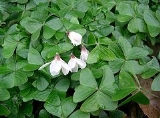
Oxalis
Encyclopedia
Oxalis is by far the largest genus
in the wood-sorrel family Oxalidaceae
: of the approximately 900 known species
in the Oxalidaceae, 800 belong here. The genus occurs throughout most of the world, except for the polar
areas; species diversity is particularly rich in tropical Brazil
, Mexico
and South Africa
.
Many of the species are known as wood-sorrels (in American English
typically written "woodsorrels" or "wood sorrels") as they have an acidic taste reminiscent of the unrelated sorrel
(Rumex acetosa) proper. Some species are called yellow-sorrels or pink-sorrels after the color of their flowers instead. Other species are colloquially known as false shamrock
s, and some are rather misleadingly called "sourgrass
es". For the genus as a whole, the term oxalises is also used.
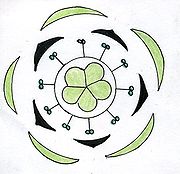 These plants are annual
These plants are annual
or perennial
. The leaves
are divided into three to ten or more obovate and top notched leaflets, arranged palmately with all the leaflets of roughly equal size. The majority of species have three leaflets; in these species, the leaves are superficially similar to those of some clover
s. Some species exhibit rapid changes in leaf angle in response to temporarily high light intensity to decrease photoinhibition
.
The flower
s have five petal
s, which are usually fused at the base, and ten stamen
s. The petal color varies from white to pink, red or yellow; anthocyanin
s and xanthophyll
s may be present or absent but are generally not both present together in significant quantities, meaning that few wood-sorrels have bright orange flowers. The fruit
is a small capsule
containing several seed
s. The root
s are often tuber
ous and succulent
, and several species also reproduce vegetatively by production of bulb
ils, which detach to produce new plants.
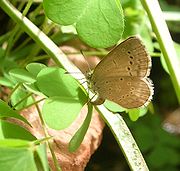 Several Oxalis species dominate the plant life in local woodland
Several Oxalis species dominate the plant life in local woodland
ecosystem
s, be it in the Coast Range ecoregion of the North America
n Pacific Northwest
, or the Sydney Turpentine-Ironbark Forest
in southeastern Australia
where least yellow sorrel (O. exilis) is common. In the United Kingdom
and neighboring Europe
, common wood sorrel
(O. acetosella) is the typical woodland member of this genus, forming large swaths in the typical mixed deciduous forests dominated by downy birch (Betula pubescens) and sessile oak (Quercus petraea), by sycamore maple (Acer pseudoplatanus), common bracken
(Pteridium aquilinum), pedunculate oak (Q. robur) and blackberries (Rubus fruticosus agg.), or by common ash (Fraxinus excelsior), dog's mercury
(Mercurialis perennis) and European rowan (Sorbus aucuparia
); it is also common in woods of common juniper (Juniperus communis
ssp. communis). Some species – notably Bermuda-buttercup
(O. pes-caprae) and creeping woodsorrel (O. corniculata) – are pernicious invasive
weed
s when escaping from cultivation outside their native ranges; the ability of most wood-sorrels to store reserve energy in their tuber
s makes them quite resistant to most weed control
techniques.
Tuberous woodsorrels provide food for certain small herbivore
s – such as the Montezuma Quail
(Cyrtonyx montezumae). The foliage is eaten by some Lepidoptera
, such as the Polyommatini
Pale Grass Blue (Pseudozizeeria maha) – which feeds on creeping wood sorrel and others – and Dark Grass Blue (Zizeeria lysimon).
The edible tuber
s of the oca
(O. tuberosa), somewhat similar to a small potato
, have long been cultivated for food in Colombia
and elsewhere in the northern Andes
mountain
s of South America
. The leaves of scurvy-grass sorrel (O. enneaphylla) were eaten by sailor
s travelling around Patagonia
as a source of vitamin C
to avoid scurvy
. In India
, creeping wood sorrel (O. corniculata) is only eaten seasonally, starting December/January. The leaves of common wood sorrel
(O. acetosella) may be used to make a lemony-tasting tea when dried.
 A characteristic of members of this genus is that they contain oxalic acid
A characteristic of members of this genus is that they contain oxalic acid
(whose name references the genus), giving the leaves and flowers a sour taste which can make them refreshing to chew. In very large amounts, oxalic acid may be considered slightly toxic, interfering with proper digestion
and kidney
function. It should be noted, however, that oxalic acid is also present in more commonly consumed foods such as spinach, broccoli, brussel sprouts, grapefruit, chives, and rhubarb, among many others. General scientific consensus seems to be that the risk of sheer toxicity, actual poisoning from oxalic acid, in persons with normal kidney function is "wildly unlikely". The U.S. National Institutes of Health note that oxalic acid is present in many foodstuffs found in the supermarket and its toxicity is generally of little or no consequence for people who eat a variety of foods.
In the past, it was a practice to extract crystals of calcium oxalate
for use in treating diseases and as a salt called sal acetosella or "sorrel salt" (also known as "salt of lemon"). Growing oca tuber root cap
s are covered in a fluorescent slush rich in harmaline
and harmine
which apparently suppresses pests; this phenomenon has been studied to some extent at the Colorado State University
. Creeping wood sorrel and perhaps other species are apparently hyperaccumulators of copper
. The Ming Dynasty
text Precious Secrets of the Realm of the King of Xin from 1421 describes how O. corniculata can be used to locate copper deposits as well as for geobotanical prospecting
. It thus ought to have some potential for phytoremediation
of contaminated soils.
Several species are grown as pot plants or as ornamental plant
s in garden
s. Species with four regular leaflets – in particular O. tetraphylla
(four-leaved pink-sorrel) – are sometimes misleadingly sold as "four-leaf clover
", taking advantage of the mystical status of four-leaf clover
s (see image to right).
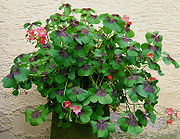
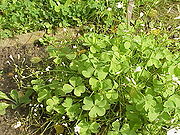
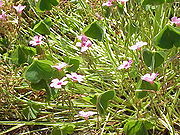
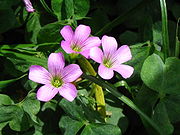
_in_hyderabad,_ap_w_img_9725.jpg)
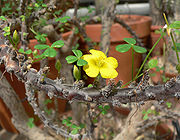
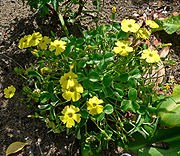

_2.jpg)
Genus
In biology, a genus is a low-level taxonomic rank used in the biological classification of living and fossil organisms, which is an example of definition by genus and differentia...
in the wood-sorrel family Oxalidaceae
Oxalidaceae
The Oxalidaceae, or wood sorrel family, are a small family of eight genera of herbaceous plants, shrubs and small trees, with the great majority of the 900 species in the genus Oxalis...
: of the approximately 900 known species
Species
In biology, a species is one of the basic units of biological classification and a taxonomic rank. A species is often defined as a group of organisms capable of interbreeding and producing fertile offspring. While in many cases this definition is adequate, more precise or differing measures are...
in the Oxalidaceae, 800 belong here. The genus occurs throughout most of the world, except for the polar
Polar region
Earth's polar regions are the areas of the globe surrounding the poles also known as frigid zones. The North Pole and South Pole being the centers, these regions are dominated by the polar ice caps, resting respectively on the Arctic Ocean and the continent of Antarctica...
areas; species diversity is particularly rich in tropical Brazil
Brazil
Brazil , officially the Federative Republic of Brazil , is the largest country in South America. It is the world's fifth largest country, both by geographical area and by population with over 192 million people...
, Mexico
Mexico
The United Mexican States , commonly known as Mexico , is a federal constitutional republic in North America. It is bordered on the north by the United States; on the south and west by the Pacific Ocean; on the southeast by Guatemala, Belize, and the Caribbean Sea; and on the east by the Gulf of...
and South Africa
South Africa
The Republic of South Africa is a country in southern Africa. Located at the southern tip of Africa, it is divided into nine provinces, with of coastline on the Atlantic and Indian oceans...
.
Many of the species are known as wood-sorrels (in American English
American English
American English is a set of dialects of the English language used mostly in the United States. Approximately two-thirds of the world's native speakers of English live in the United States....
typically written "woodsorrels" or "wood sorrels") as they have an acidic taste reminiscent of the unrelated sorrel
Sorrel
Common sorrel or garden sorrel , often simply called sorrel, is a perennial herb that is cultivated as a garden herb or leaf vegetable...
(Rumex acetosa) proper. Some species are called yellow-sorrels or pink-sorrels after the color of their flowers instead. Other species are colloquially known as false shamrock
Shamrock
The shamrock is a three-leafed old white clover. It is known as a symbol of Ireland. The name shamrock is derived from Irish , which is the diminutive version of the Irish word for clover ....
s, and some are rather misleadingly called "sourgrass
Sourgrass
Sourgrass is a common name given to several plant species which have a sour taste. Most are in fact not grasses:* Digitaria insularis, a true grass * Oxalis species of the Oxalidaceae, namely:...
es". For the genus as a whole, the term oxalises is also used.
Description and ecology

Annual plant
An annual plant is a plant that usually germinates, flowers, and dies in a year or season. True annuals will only live longer than a year if they are prevented from setting seed...
or perennial
Perennial plant
A perennial plant or simply perennial is a plant that lives for more than two years. The term is often used to differentiate a plant from shorter lived annuals and biennials. The term is sometimes misused by commercial gardeners or horticulturalists to describe only herbaceous perennials...
. The leaves
Leaf
A leaf is an organ of a vascular plant, as defined in botanical terms, and in particular in plant morphology. Foliage is a mass noun that refers to leaves as a feature of plants....
are divided into three to ten or more obovate and top notched leaflets, arranged palmately with all the leaflets of roughly equal size. The majority of species have three leaflets; in these species, the leaves are superficially similar to those of some clover
Clover
Clover , or trefoil, is a genus of about 300 species of plants in the leguminous pea family Fabaceae. The genus has a cosmopolitan distribution; the highest diversity is found in the temperate Northern Hemisphere, but many species also occur in South America and Africa, including at high altitudes...
s. Some species exhibit rapid changes in leaf angle in response to temporarily high light intensity to decrease photoinhibition
Photoinhibition
Photoinhibition is light-induced reduction in the photosynthetic capacity of a plant, alga, or cyanobacterium. Photosystem II is more sensitive to light than the rest of the photosynthetic machinery, and most researchers define the term as light-induced damage to PSII...
.
The flower
Flower
A flower, sometimes known as a bloom or blossom, is the reproductive structure found in flowering plants . The biological function of a flower is to effect reproduction, usually by providing a mechanism for the union of sperm with eggs...
s have five petal
Petal
Petals are modified leaves that surround the reproductive parts of flowers. They often are brightly colored or unusually shaped to attract pollinators. Together, all of the petals of a flower are called a corolla. Petals are usually accompanied by another set of special leaves called sepals lying...
s, which are usually fused at the base, and ten stamen
Stamen
The stamen is the pollen producing reproductive organ of a flower...
s. The petal color varies from white to pink, red or yellow; anthocyanin
Anthocyanin
Anthocyanins are water-soluble vacuolar pigments that may appear red, purple, or blue according to pH...
s and xanthophyll
Xanthophyll
Xanthophylls are yellow pigments that form one of two major divisions of the carotenoid group. The name is from Greek xanthos + phyllon , due to their formation of the yellow band seen in early chromatography of leaf pigments...
s may be present or absent but are generally not both present together in significant quantities, meaning that few wood-sorrels have bright orange flowers. The fruit
Fruit
In broad terms, a fruit is a structure of a plant that contains its seeds.The term has different meanings dependent on context. In non-technical usage, such as food preparation, fruit normally means the fleshy seed-associated structures of certain plants that are sweet and edible in the raw state,...
is a small capsule
Capsule (fruit)
In botany a capsule is a type of simple, dry fruit produced by many species of flowering plants. A capsule is a structure composed of two or more carpels that in most cases is dehiscent, i.e. at maturity, it splits apart to release the seeds within. A few capsules are indehiscent, for example...
containing several seed
Seed
A seed is a small embryonic plant enclosed in a covering called the seed coat, usually with some stored food. It is the product of the ripened ovule of gymnosperm and angiosperm plants which occurs after fertilization and some growth within the mother plant...
s. The root
Root
In vascular plants, the root is the organ of a plant that typically lies below the surface of the soil. This is not always the case, however, since a root can also be aerial or aerating . Furthermore, a stem normally occurring below ground is not exceptional either...
s are often tuber
Tuber
Tubers are various types of modified plant structures that are enlarged to store nutrients. They are used by plants to survive the winter or dry months and provide energy and nutrients for regrowth during the next growing season and they are a means of asexual reproduction...
ous and succulent
Succulent plant
Succulent plants, also known as succulents or fat plants, are water-retaining plants adapted to arid climates or soil conditions. Succulent plants store water in their leaves, stems, and also in roots...
, and several species also reproduce vegetatively by production of bulb
Bulb
A bulb is a short stem with fleshy leaves or leaf bases. The leaves often function as food storage organs during dormancy.A bulb's leaf bases, known as scales, generally do not support leaves, but contain food reserves to enable the plant to survive adverse conditions. At the center of the bulb is...
ils, which detach to produce new plants.

Woodland
Ecologically, a woodland is a low-density forest forming open habitats with plenty of sunlight and limited shade. Woodlands may support an understory of shrubs and herbaceous plants including grasses. Woodland may form a transition to shrubland under drier conditions or during early stages of...
ecosystem
Ecosystem
An ecosystem is a biological environment consisting of all the organisms living in a particular area, as well as all the nonliving , physical components of the environment with which the organisms interact, such as air, soil, water and sunlight....
s, be it in the Coast Range ecoregion of the North America
North America
North America is a continent wholly within the Northern Hemisphere and almost wholly within the Western Hemisphere. It is also considered a northern subcontinent of the Americas...
n Pacific Northwest
Pacific Northwest
The Pacific Northwest is a region in northwestern North America, bounded by the Pacific Ocean to the west and, loosely, by the Rocky Mountains on the east. Definitions of the region vary and there is no commonly agreed upon boundary, even among Pacific Northwesterners. A common concept of the...
, or the Sydney Turpentine-Ironbark Forest
Sydney Turpentine-Ironbark Forest
The Sydney Turpentine-Ironbark Forest is one of six main indigenous forest communities of Sydney, New South Wales, Australia. It is also among the three of these plant communities which have been classified as Endangered, under the New South Wales government's Threatened Species Conservation Act...
in southeastern Australia
Australia
Australia , officially the Commonwealth of Australia, is a country in the Southern Hemisphere comprising the mainland of the Australian continent, the island of Tasmania, and numerous smaller islands in the Indian and Pacific Oceans. It is the world's sixth-largest country by total area...
where least yellow sorrel (O. exilis) is common. In the United Kingdom
United Kingdom
The United Kingdom of Great Britain and Northern IrelandIn the United Kingdom and Dependencies, other languages have been officially recognised as legitimate autochthonous languages under the European Charter for Regional or Minority Languages...
and neighboring Europe
Europe
Europe is, by convention, one of the world's seven continents. Comprising the westernmost peninsula of Eurasia, Europe is generally 'divided' from Asia to its east by the watershed divides of the Ural and Caucasus Mountains, the Ural River, the Caspian and Black Seas, and the waterways connecting...
, common wood sorrel
Common wood sorrel
Common Wood-sorrel is a plant from the genus Oxalis, common in most of Europe and parts of Asia. The binomial name is Oxalis acetosella, because of its sour taste. In much of its range it is the only member of its genus and hence simply known as "the" wood-sorrel...
(O. acetosella) is the typical woodland member of this genus, forming large swaths in the typical mixed deciduous forests dominated by downy birch (Betula pubescens) and sessile oak (Quercus petraea), by sycamore maple (Acer pseudoplatanus), common bracken
Bracken
Bracken are several species of large, coarse ferns of the genus Pteridium. Ferns are vascular plants that have alternating generations, large plants that produce spores and small plants that produce sex cells . Brackens are in the family Dennstaedtiaceae, which are noted for their large, highly...
(Pteridium aquilinum), pedunculate oak (Q. robur) and blackberries (Rubus fruticosus agg.), or by common ash (Fraxinus excelsior), dog's mercury
Dog's Mercury
Mercurialis perennis, commonly known as dog's mercury, is a woodland plant found in much of Europe, but almost absent from Ireland, Orkney and Shetland. A member of the spurge family , it is a herbaceous, downy perennial with erect stems bearing simple, serrate leaves. The dioecious inflorescences...
(Mercurialis perennis) and European rowan (Sorbus aucuparia
Sorbus aucuparia
Sorbus aucuparia , is a species of the genus Sorbus, native to most of Europe except for the far south, and northern Asia...
); it is also common in woods of common juniper (Juniperus communis
Juniperus communis
Juniperus communis, the Common Juniper, is a species in the genus Juniperus, in the family Cupressaceae. It has the largest range of any woody plant, throughout the cool temperate Northern Hemisphere from the Arctic south in mountains to around 30°N latitude in North America, Europe and Asia.-...
ssp. communis). Some species – notably Bermuda-buttercup
Oxalis pes-caprae
Oxalis pes-caprae is a species of tristylous flowering plant in the wood sorrel family Oxalidaceae...
(O. pes-caprae) and creeping woodsorrel (O. corniculata) – are pernicious invasive
Invasive species
"Invasive species", or invasive exotics, is a nomenclature term and categorization phrase used for flora and fauna, and for specific restoration-preservation processes in native habitats, with several definitions....
weed
Weed
A weed in a general sense is a plant that is considered by the user of the term to be a nuisance, and normally applied to unwanted plants in human-controlled settings, especially farm fields and gardens, but also lawns, parks, woods, and other areas. More specifically, the term is often used to...
s when escaping from cultivation outside their native ranges; the ability of most wood-sorrels to store reserve energy in their tuber
Tuber
Tubers are various types of modified plant structures that are enlarged to store nutrients. They are used by plants to survive the winter or dry months and provide energy and nutrients for regrowth during the next growing season and they are a means of asexual reproduction...
s makes them quite resistant to most weed control
Weed control
Weed control is the botanical component of pest control, using physical and chemical methods to stop weeds from reaching a mature stage of growth when they could be harmful to domesticated plants and livestock...
techniques.
Tuberous woodsorrels provide food for certain small herbivore
Herbivore
Herbivores are organisms that are anatomically and physiologically adapted to eat plant-based foods. Herbivory is a form of consumption in which an organism principally eats autotrophs such as plants, algae and photosynthesizing bacteria. More generally, organisms that feed on autotrophs in...
s – such as the Montezuma Quail
Montezuma Quail
The Montezuma Quail is a stubby, secretive New World quail of Mexico and some nearby parts of the United States. It is also known as Mearns's Quail, the Harlequin Quail , and the Fool Quail .-Description:At about 22 cm , it is one of the shortest quails of North America, although it weighs 180 g...
(Cyrtonyx montezumae). The foliage is eaten by some Lepidoptera
Lepidoptera
Lepidoptera is a large order of insects that includes moths and butterflies . It is one of the most widespread and widely recognizable insect orders in the world, encompassing moths and the three superfamilies of butterflies, skipper butterflies, and moth-butterflies...
, such as the Polyommatini
Polyommatini
Polyommatini is a tribe of lycaenid butterflies in the subfamily Polyommatinae. They were extensively studied by lepidopterist Vladimir Nabokov.-Doubtful Polyommatini:...
Pale Grass Blue (Pseudozizeeria maha) – which feeds on creeping wood sorrel and others – and Dark Grass Blue (Zizeeria lysimon).
Use by humans
Wood sorrel is an edible wild plant that has been consumed by humans around the world for millennia. In Dr. James Duke's "Handbook of Edible Weeds," he notes that the Kiowa Indian tribe chewed wood sorrel to alleviate thirst on long trips, that the Potawatomi Indians cooked it with sugar to make a dessert, the Algonquin Indians considered it an aphrodisiac, the Cherokee ate wood sorrel to alleviate mouth sores and a sore throat, and the Iroquois ate wood sorrel to help with cramps, fever and nausea.The edible tuber
Tuber
Tubers are various types of modified plant structures that are enlarged to store nutrients. They are used by plants to survive the winter or dry months and provide energy and nutrients for regrowth during the next growing season and they are a means of asexual reproduction...
s of the oca
Oca
Oxalis tuberosa is an herbaceous perennial plant that overwinters as underground stem tubers. These tubers are known as oca, oka, or New Zealand Yam. The plant was brought into cultivation in the central and southern Andes for its tubers, which are used as a root vegetable...
(O. tuberosa), somewhat similar to a small potato
Potato
The potato is a starchy, tuberous crop from the perennial Solanum tuberosum of the Solanaceae family . The word potato may refer to the plant itself as well as the edible tuber. In the region of the Andes, there are some other closely related cultivated potato species...
, have long been cultivated for food in Colombia
Colombia
Colombia, officially the Republic of Colombia , is a unitary constitutional republic comprising thirty-two departments. The country is located in northwestern South America, bordered to the east by Venezuela and Brazil; to the south by Ecuador and Peru; to the north by the Caribbean Sea; to the...
and elsewhere in the northern Andes
Andes
The Andes is the world's longest continental mountain range. It is a continual range of highlands along the western coast of South America. This range is about long, about to wide , and of an average height of about .Along its length, the Andes is split into several ranges, which are separated...
mountain
Mountain
Image:Himalaya_annotated.jpg|thumb|right|The Himalayan mountain range with Mount Everestrect 58 14 160 49 Chomo Lonzorect 200 28 335 52 Makalurect 378 24 566 45 Mount Everestrect 188 581 920 656 Tibetan Plateaurect 250 406 340 427 Rong River...
s of South America
South America
South America is a continent situated in the Western Hemisphere, mostly in the Southern Hemisphere, with a relatively small portion in the Northern Hemisphere. The continent is also considered a subcontinent of the Americas. It is bordered on the west by the Pacific Ocean and on the north and east...
. The leaves of scurvy-grass sorrel (O. enneaphylla) were eaten by sailor
Sailor
A sailor, mariner, or seaman is a person who navigates water-borne vessels or assists in their operation, maintenance, or service. The term can apply to professional mariners, military personnel, and recreational sailors as well as a plethora of other uses...
s travelling around Patagonia
Patagonia
Patagonia is a region located in Argentina and Chile, integrating the southernmost section of the Andes mountains to the southwest towards the Pacific ocean and from the east of the cordillera to the valleys it follows south through Colorado River towards Carmen de Patagones in the Atlantic Ocean...
as a source of vitamin C
Vitamin C
Vitamin C or L-ascorbic acid or L-ascorbate is an essential nutrient for humans and certain other animal species. In living organisms ascorbate acts as an antioxidant by protecting the body against oxidative stress...
to avoid scurvy
Scurvy
Scurvy is a disease resulting from a deficiency of vitamin C, which is required for the synthesis of collagen in humans. The chemical name for vitamin C, ascorbic acid, is derived from the Latin name of scurvy, scorbutus, which also provides the adjective scorbutic...
. In India
India
India , officially the Republic of India , is a country in South Asia. It is the seventh-largest country by geographical area, the second-most populous country with over 1.2 billion people, and the most populous democracy in the world...
, creeping wood sorrel (O. corniculata) is only eaten seasonally, starting December/January. The leaves of common wood sorrel
Common wood sorrel
Common Wood-sorrel is a plant from the genus Oxalis, common in most of Europe and parts of Asia. The binomial name is Oxalis acetosella, because of its sour taste. In much of its range it is the only member of its genus and hence simply known as "the" wood-sorrel...
(O. acetosella) may be used to make a lemony-tasting tea when dried.

Oxalic acid
Oxalic acid is an organic compound with the formula H2C2O4. This colourless solid is a dicarboxylic acid. In terms of acid strength, it is about 3,000 times stronger than acetic acid. Oxalic acid is a reducing agent and its conjugate base, known as oxalate , is a chelating agent for metal cations...
(whose name references the genus), giving the leaves and flowers a sour taste which can make them refreshing to chew. In very large amounts, oxalic acid may be considered slightly toxic, interfering with proper digestion
Digestion
Digestion is the mechanical and chemical breakdown of food into smaller components that are more easily absorbed into a blood stream, for instance. Digestion is a form of catabolism: a breakdown of large food molecules to smaller ones....
and kidney
Kidney
The kidneys, organs with several functions, serve essential regulatory roles in most animals, including vertebrates and some invertebrates. They are essential in the urinary system and also serve homeostatic functions such as the regulation of electrolytes, maintenance of acid–base balance, and...
function. It should be noted, however, that oxalic acid is also present in more commonly consumed foods such as spinach, broccoli, brussel sprouts, grapefruit, chives, and rhubarb, among many others. General scientific consensus seems to be that the risk of sheer toxicity, actual poisoning from oxalic acid, in persons with normal kidney function is "wildly unlikely". The U.S. National Institutes of Health note that oxalic acid is present in many foodstuffs found in the supermarket and its toxicity is generally of little or no consequence for people who eat a variety of foods.
In the past, it was a practice to extract crystals of calcium oxalate
Calcium oxalate
Calcium oxalate is a chemical compound that forms needle-shaped crystals, known in plants as raphides. A major constituent of human kidney stones, the chemical is also found in beerstone, a scale that forms on containers used in breweries...
for use in treating diseases and as a salt called sal acetosella or "sorrel salt" (also known as "salt of lemon"). Growing oca tuber root cap
Root cap
The root cap is a section of tissue at the tip of a plant root. It is also called calyptra. Root caps contain statocytes which are involved in gravity perception in plants. If the cap is carefully removed the root will grow randomly. The root cap protects the growing tip in plants...
s are covered in a fluorescent slush rich in harmaline
Harmaline
Harmaline is a fluorescent psychoactive indole alkaloid from the group of harmala alkaloids and beta-carbolines. It is the reduced hydrogenated form of harmine.-Occurrence in nature:...
and harmine
Harmine
Harmine is a fluorescent harmala alkaloid belonging to the beta-carboline family of compounds. It occurs in a number of different plants, most notably the Middle Eastern plant harmal or Syrian rue and the South American vine Banisteriopsis caapi...
which apparently suppresses pests; this phenomenon has been studied to some extent at the Colorado State University
Colorado State University
Colorado State University is a public research university located in Fort Collins, Colorado. The university is the state's land grant university, and the flagship university of the Colorado State University System.The enrollment is approximately 29,932 students, including resident and...
. Creeping wood sorrel and perhaps other species are apparently hyperaccumulators of copper
Copper
Copper is a chemical element with the symbol Cu and atomic number 29. It is a ductile metal with very high thermal and electrical conductivity. Pure copper is soft and malleable; an exposed surface has a reddish-orange tarnish...
. The Ming Dynasty
Ming Dynasty
The Ming Dynasty, also Empire of the Great Ming, was the ruling dynasty of China from 1368 to 1644, following the collapse of the Mongol-led Yuan Dynasty. The Ming, "one of the greatest eras of orderly government and social stability in human history", was the last dynasty in China ruled by ethnic...
text Precious Secrets of the Realm of the King of Xin from 1421 describes how O. corniculata can be used to locate copper deposits as well as for geobotanical prospecting
Geobotanical Prospecting
Geobotanical prospecting refers to prospecting based on the analysis of the vegetation. The Viscaria Mine in Sweden was named after the flower Viscaria Alpina that was used by prospecters to discover the ore deposits....
. It thus ought to have some potential for phytoremediation
Phytoremediation
Phytoremediation Phytoremediation Phytoremediation (from the Ancient Greek , and Latin (restoring balance or remediation) describes the treatment of environmental problems (bioremediation) through the use of plants that mitigate the environmental problem without the need to excavate the...
of contaminated soils.
Several species are grown as pot plants or as ornamental plant
Ornamental plant
Ornamental plants are plants that are grown for decorative purposes in gardens and landscape design projects, as house plants, for cut flowers and specimen display...
s in garden
Garden
A garden is a planned space, usually outdoors, set aside for the display, cultivation, and enjoyment of plants and other forms of nature. The garden can incorporate both natural and man-made materials. The most common form today is known as a residential garden, but the term garden has...
s. Species with four regular leaflets – in particular O. tetraphylla
Oxalis tetraphylla
Oxalis tetraphylla is a bulbous plant from Mexico. A common name is "Iron Cross", after a famous cultivar; it is also known as "lucky clover", and in a wild or feral state as Four-leaf Sorrel or, least ambiguously, Four-leaved Pink-sorrel.It has leaves divided into four and has been called "lucky...
(four-leaved pink-sorrel) – are sometimes misleadingly sold as "four-leaf clover
Clover
Clover , or trefoil, is a genus of about 300 species of plants in the leguminous pea family Fabaceae. The genus has a cosmopolitan distribution; the highest diversity is found in the temperate Northern Hemisphere, but many species also occur in South America and Africa, including at high altitudes...
", taking advantage of the mystical status of four-leaf clover
Four-leaf clover
The four-leaf clover is an uncommon variation of the common, three-leaved clover. According to tradition, such leaves bring good luck to their finders, especially if found accidentally...
s (see image to right).

Selected species
Source USDA


_in_hyderabad,_ap_w_img_9725.jpg)



_2.jpg)
External links
- Plant Profile for Oxalis – USDA Plant Database
- Glossary of Archaic Chemical Terms: Sorrel
- Oxalis
- Pictures and Information of Oxalis adenophylla in Chile
- Pacific Bulb Society website – with many references to Oxalis species

